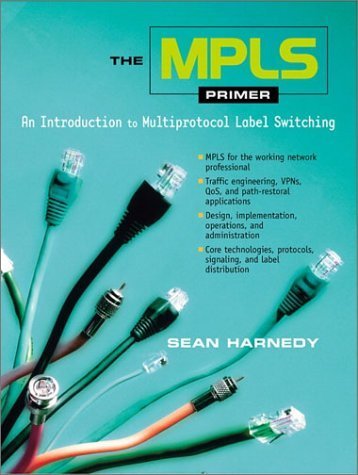Mpls Primer Introduction Multiprotocol by Harnedy Sean (1 results)
Product Type
- All Product Types
- Books (1)
- Magazines & Periodicals
- Comics
- Sheet Music
- Art, Prints & Posters
- Photographs
- Maps
-
Manuscripts &
Paper Collectibles
Condition
- All Conditions
- New
- Used
Binding
- All Bindings
- Hardcover
- Softcover
Collectible Attributes
- First Edition
- Signed
- Dust Jacket
- Seller-Supplied Images
- Not Printed On Demand
Seller Location
Seller Rating
-
The MPLS Primer; An Introduction to Multiprotocol Label Switching
Published by Prentice Hall, Upper Saddle River, 2002
ISBN 10: 0130329800ISBN 13: 9780130329806
Seller: Ground Zero Books, Ltd., Silver Spring, MD, U.S.A.
Book First Edition
Hardcover. Condition: Very good. First Printing [Stated]. The format is approximately 7.125 inches by 9.675 inches. xxvi, 484, [2] pages. Footnotes. Illustrations. Tabular Data. References. Appendixes. Bibliography and Web Sites. Index. Glossary with Acronyms. Index. No DJ present. Cover has slight wear and soiling. A heavy book and if sent outside of the U.S. will require additional shipping charges. This introduction covers the concepts, standards, evolution, design, implementation, and daily operations of MPLS. Core technologies, signaling, label distribution, and management are all detailed. Appendixes include a chronology (1992-2001), an RFC index, coverage of RFC 3031 and 3032, introductions to SNMP and SNMP3, and a glossary. Sean Harnedy is a networking consultant and a software engineer. He's the author of several Prentice Hall books on network management, including 'Total SNMP' and 'Web-Based Management for the Enterprise'. He earned a B.A. from Holy Cross College, a B.S. in computer Science from Florida Atlantic University, and a M.S. in Computer Science from the University of New Haven. He has over 30 years of experience as a software engineer and technology consultant with expertise in Enterprise and Data Architecture along with Information Exchange Specifications and Data Science. Proven success across the the entire software development cycle in both structured and object-oriented environments, including extensive systems programming development and debugging especially in network management, security, telecommunications, data communications, information exchange, and protocol development. Multiprotocol Label Switching (MPLS) is a routing technique in telecommunications networks that directs data from one node to the next based on labels rather than network addresses. Whereas network addresses identify endpoints, the labels identify established paths between endpoints. MPLS can encapsulate packets of various network protocols, hence the multiprotocol component of the name. MPLS supports a range of access technologies, including T1/E1, ATM, Frame Relay, and DSL. In an MPLS network, labels are assigned to data packets. Packet-forwarding decisions are made solely on the contents of this label, without the need to examine the packet itself. This allows one to create end-to-end circuits across any type of transport medium, using any protocol. The primary benefit is to eliminate dependence on a particular OSI model data link layer (layer 2) technology, and eliminate the need for multiple layer-2 networks to satisfy different types of traffic. Multiprotocol label switching belongs to the family of packet-switched networks. MPLS operates at a layer that is generally considered to lie between traditional definitions of OSI Layer 2 (data link layer) and Layer 3 (network layer), and thus is often referred to as a layer 2.5 protocol. It was designed to provide a unified data-carrying service for both circuit-based clients and packet-switching clients which provide a datagram service model. It can be used to carry many different kinds of traffic, including IP packets, as well as native Asynchronous Transfer Mode (ATM), Frame Relay, Synchronous Optical Networking (SONET) or Ethernet. A number of different technologies were previously deployed with essentially identical goals, such as Frame Relay and ATM. Frame Relay and ATM use labels to move frames or cells through a network. The header of the Frame Relay frame and the ATM cell refers to the virtual circuit that the frame or cell resides on. The similarity between Frame Relay, ATM, and MPLS is that at each hop throughout the network, the label value in the header is changed. This is different from the forwarding of IP packets.[2] MPLS technologies have evolved with the strengths and weaknesses of ATM in mind. MPLS is designed to have lower overhead than ATM while providing connection-oriented services for variable-length frames, and has replaced much use of ATM in the market. MPLS dispenses with the cell-switching and signaling-protocol baggage of ATM. MPLS recognizes that small ATM cells are not needed in the core of modern networks, since modern optical networks are fast enough that even full-length 1500 byte packets do not incur significant real-time queuing delays.[a] At the same time, MPLS attempts to preserve the traffic engineering (TE) and out-of-band control that made Frame Relay and ATM attractive for deploying large-scale networks.


